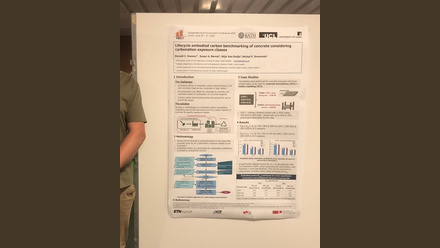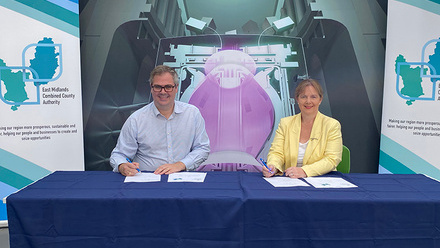Responsible research and innovation
What is the responsibility of those scientists who are conducting research and teaching at universities? Dr Ilija Rašović MIMMM, Lecturer in Materials and Natural Sciences at the University of Birmingham, UK, and Vice-Chair of the IOM3 Student and Early Career Committee, raises the stakes as he navigates responsible research and innovation.

The great American physicist, Richard Feynman, contended, 'It is our responsibility as scientists, knowing the great progress and great value of a satisfactory philosophy of ignorance, the great progress that is the fruit of freedom of thought, to proclaim the value of this freedom, to teach how doubt is not to be feared but welcomed and discussed, and to demand this freedom as our duty to all coming generations.' You may well have a different opinion as to a scientist’s responsibility. Some of you may well think the obvious and it’s not worth grandiose philosophising. History, however, warns us not to be so blasé.
Plastic fantastic?
The case study that is not only understood by every materials scientist, but that also affects almost every member of modern society, is plastics. Advances in scientific understanding and innovation throughout the 20th Century brought us a library of materials of immense adaptability, performance and durability at mouth-wateringly low economic wcost.
But we now know, and indeed live through, the staggering downstream environmental and health implications of this boom when the materials are not well managed at the end of their life. From garbage patches in the open oceans to sedimentary deposits, macroplastics ensnaring wildlife, to microplastics entering our own bodies – the ubiquity and ill effects of plastic waste are something that a huge number of people are grappling with. Entire industries are trying either to stench the flow of waste such as through recycling and the circular economy, by synthesising new recyclable/degradable plastics, or cleaning up the vast swathes already out there.
And all of this effort stemming from initial exploration driven by scientific curiosity and the desire to synthesise new materials instead of relying on depleting and unreliable natural sources. We were just trying to do better.
While we try to tidy up the mess, we find ourselves in the midst of another story of rapid technological advancement unfolding before our eyes – that of artificial intelligence (AI). More specifically, publicly available AI via powerful large language models (LLMs), such as OpenAI’s ChatGPT.
In the space of just a couple of months at the beginning of 2023, we went from the latest iterations of these LLMs being launched for public consumption, to the publication of an open letter calling for a pause in training of more advanced models. Italy even banned access to ChatGPT, for safety and privacy concerns.
Collective experience of previous runaway technological innovation has placed a burden of responsibility upon the shoulders of the computer scientists who are researching and innovating in AI.
Another seminal case study in the same vein, is nuclear fission giving rise to both nuclear energy and the atomic bomb. I believe it is in grappling with this duality where the responsibility of the scientist centres, as Feynman also noted when recounting a quote said to him by a Buddhist monk: 'To every man is given the key to the gates of heaven. The same key opens the gates of hell.'
The ivory tower
But to whom is any responsibility owed? Ultimately, one’s fellow humans. This can feel unwieldy and irrelevant to some scientists working at the laboratory bench or on their computer code day-in and day-out, often on esoteric fundamental research, leading them to disengage with this responsibility and contribute another brick to the wall of the ivory tower separating academic scientific research from the rest of society.
However, the results of scientific research will always refuse to be siloed away. It is an intrinsic property of the accumulation of knowledge via the scientific method – the famed standing on the shoulders of giants. No matter how seemingly detached from application, research will be built upon by future generations, perhaps ultimately leading to an unforeseen technological breakthrough. Knowledge will always percolate through into the arena of wider society.
I think it is interesting and worthwhile for the materials, minerals and mining community to consider this in light of the fact that our subjects straddle the science-engineering boundary. While science generally operates in the realm of the lowest technology readiness levels (TRLs), before any application has been validated in the wider world, engineering spans through to the very highest TRLs. It has an established porous interface with society, where anyone and everyone is likely to interact with its work – think bridges (civil engineering) and electricity supplies (electrical engineering). Professional codes of conduct, certifications, standards, and much more all exist, and topics such as ethics, sustainability and public consultation are part and parcel of training programmes. What could scientists learn from this?
Defining responsibility
In the late 2000s, in an effort to better engage researchers with their burden of responsibility, the EU spearheaded the adoption of the concept of Responsible Research and Innovation (RRI). They defined this as having six key components – research ethics, STEM education, gender equality, open access, governance and public engagement.
The EU has attempted to integrate these RRI principles into the wider European research and innovation system via a Horizon 2020-funded project, NewHoRRIzon. The project’s outcomes include, among others, a catalogue of pilot actions from across the continent as well as resources that research teams can access to help adopt RRI principles into their work.
The idea of RRI, and its language, were soon adopted by the UK’s Engineering and Physical Sciences Research Council (EPSRC), and have shaped the development of an RRI framework – dubbed AREA – that has since been incorporated across the entirety of UK Research and Innovation (UKRI).
The acronym AREA – Anticipate, Reflect, Engage, Act – highlights the actions expected of the individual scientist when engaging with RRI principles. As UKRI says, RRI 'includes, but goes beyond, considerations of risk and regulation, important though these are'. Researchers should:
- Anticipate potential impacts (broadly considered) of their research and encourage their exploration, without the expectation to predict the future.
- Reflect on their and their research’s aims, motivations, assumptions, uncertainties and implications.
- Engage wider audiences than their specialist research community via deliberation, dialogue and debate.
- Act upon these broad RRI principles to feed into and positively affect their research and innovation processes.
If you have read the above and feel none the wiser as to what RRI is, then you are not alone. Indeed, this vagueness is a common criticism railed at RRI – it makes it hard for researchers to know exactly what to do. Even if a scientist understands it, it is not unlikely that they will lack the skills to adopt these principles, which are often not in the remit of technical training in scientific disciplines (more on this later).
Another criticism is that there is, currently, a lack of practical reward and recognition for embracing RRI as part of one’s process and practice. Worse though, is the feeling among some that RRI is anti-fundamental research. This is arguably exacerbated by the language chosen by UKRI, which is at times vague and non-committal due to its commitment to not being prescriptive – 'There may be instances where detailed consideration [of RRI] is premature or even unwarranted', it says. Other times, the language is vague and either irrelevant or unnerving depending on your viewpoint – '[RRI] is a process that seeks to promote creativity and opportunities for science and innovation that are socially desirable'.
Embedding responsible research and innovation
However you feel about RRI though, it is here to stay. For two iterations now, the EPSRC’s Centres for Doctoral Training have required their student cohorts to receive training in RRI, and a section on RRI is compulsory to complete in applications for UKRI’s funding. Slowly, but surely, a formalised mechanism for getting scientists to think about their responsibility is taking shape.
But this throws up what I think is a very interesting issue. In embedding RRI in its funding processes, UKRI has created a dichotomy between a new generation of researchers who will be trained in RRI and an incumbent workforce of group leaders and senior researchers, many of whom have little idea about RRI, who must be seen to engage with it.
How then do we bridge this divide to ensure that all researchers are aware of, and empowered and encouraged to shoulder, their responsibility and embed it in their practice? Beyond just waiting for generational turnover, I think there are several initiatives, at different scales, that should be considered.
As a fundamental basis upon which to build other work, the arguably vague nature of the language within which RRI is couched needs to be made more accessible to all scientists. The scope is so broad and occasionally ill-defined that it is not surprising that some researchers view this with scepticism.
RRI needs to become more than just an inconvenient box-ticking exercise for senior and early-career researchers alike. I see several ways of achieving this. First, guidance provided by funding bodies needs to provide concrete examples from which researchers can seek inspiration (for example, the NewHoRRIzon project). There needs to be better signposting for researchers at different positions on the spectrum from fundamental to applied research.
Universities, as employers, should also consider a financial commitment to training researchers at all levels of seniority in RRI, with time explicitly dedicated to exploring and developing RRI activity.
Further, if RRI is to become a part of what all scientists are expected to do, then such activities need to be peer-reviewed. Grant review panels need to be sufficiently conversant with RRI so that applications that incorporate bids for RRI activities can be adequately assessed. Research outputs that incorporate, to whatever extent, elements of RRI must also be similarly fairly treated – there are ongoing discussions around how, for example, a PhD thesis might incorporate such work and then be suitably examined.
Training programmes are one way to upskill the scientific workforce to engage with RRI and enable the above, but another harks back to the science-engineering axis referred to earlier. Industry has a lot to offer in this RRI space and should be better engaged.
One example where this has been done quite successfully in the UK is via the Centres for Doctoral Training, where industry support of research projects is part and parcel of the set-up. In-kind support can be sought to provide guidance on, for example, procurement ethics or indigenous population engagement.
Another mechanism universities may want to explore is the use of part-time lectureships for industry professionals to collaborate on RRI activities with academic staff, and/or provide training to undergraduate students and postgraduate researchers.
Broader education
On a long-term timescale, there needs to be a greater cultural shift beyond just the instrumental provision of training to those conducting cutting-edge research at universities. And this speaks directly to the RRI principles of STEM education and public engagement.
Understanding one’s responsibility as a scientist to the rest of society inherently requires an appreciation of topics outside the wheelhouse of one’s immediate, usually narrow, research focus. The provision of interdisciplinary education at both secondary and tertiary levels needs to be embraced and expanded. Here, Materials Science and Engineering is in an excellent position to show others how it’s done – by its very nature it interacts with a diverse array of other disciplines and enables the kind of disciplinary-spanning communication that provides its practitioners with both an open, curious and inclusive mindset, and knowledge of work and opinions in a range of technical disciplines.
To fully embed the skills and mindset required for meaningful engagement with the ideas of RRI, I would go further and suggest that we need to push for an interdisciplinary education that better incorporates the humanities alongside the STEM subjects.
If considering how best to engender a responsibility for the rest of humankind, then the key lies in the very name – humanities. The skills and knowledge gained from such subjects perfectly complement a technical education and can only enhance it. At school level, while a push towards building STEM-focused students is no bad thing, this should not be done by sacrificing the humanities side of the curriculum.
Further, at university level, there is no reason why education in such subjects cannot fit into the curriculum – indeed, there are already examples of interdisciplinary programmes doing so both in the UK and further afield. Accreditation committees of professional bodies, such as IOM3, may well want to consider how RRI principles are considered and judged in their criteria.
With their broad interdisciplinary reach and position at the interface of both science and engineering, I believe that the materials, minerals and mining communities, in both industry and academia, have a key role to play in providing guidance and examples of best practice in RRI, both to internal audiences and the wider scientific community.







